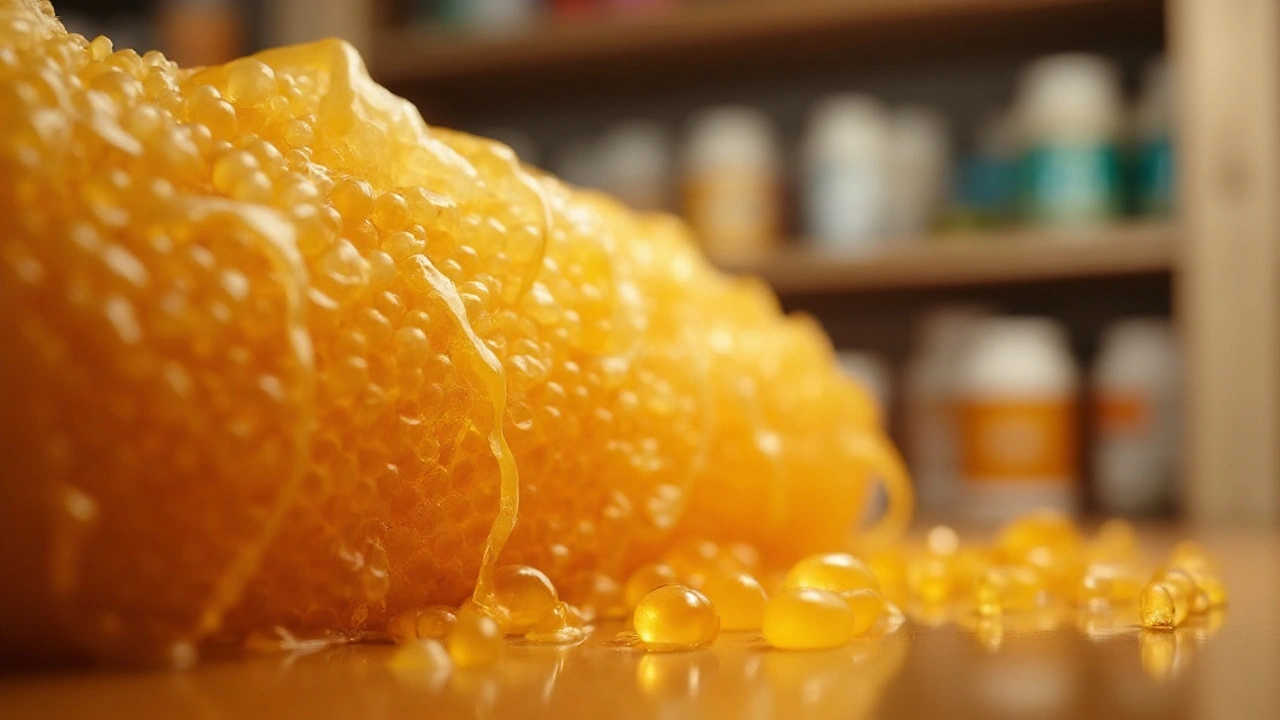Beeswax Nutrition: How to Add Natural Wax Benefits to Your Diet

Beeswax is a natural wax secreted by honeybees (Apis mellifera) that forms the structure of honeycomb, rich in fatty acids, esters, and phytosterols. While most people picture it as a candle or a sealant, the same wax can be an edible ally for your body. This article walks you through the science, practical tips, and safety notes so you can confidently explore beeswax nutrition in everyday meals.
Why Consider Beeswax in Your Diet?
Beeswax isn’t just a by‑product of honey production; it’s a complex mix of lipids, vitamins, and antioxidants that can support skin health, gut balance, and even cholesterol levels. Recent studies from the University of Sydney showed that the unique blend of fatty acids in beeswax can improve lipid profiles when consumed in small, regular amounts.
What’s Inside Beeswax?
The nutrient profile can be broken down into three main groups:
- Fatty acids: Around 12‑15% of raw wax consists of saturated (palmitic, stearic) and unsaturated (oleic) acids, which provide a steady energy source and help maintain cell membranes.
- Vitamins and minerals: Small but notable amounts of B‑complex vitamins (B1, B2, B6) and minerals such as calcium (≈ 50mg per 5g) and magnesium are present, supporting nerve function and bone health.
- Antioxidants: Polyphenols and flavonoids give beeswax a modest ORAC score (~250µmol TE/100g), enough to help neutralise free radicals after digestion.
These components work together, creating a synergistic effect that’s greater than the sum of its parts.
Beeswax and the Gut Microbiome
When beeswax reaches the small intestine, its ester bonds are partially broken down by pancreatic lipase, releasing short‑chain fatty acids (SCFAs). SCFAs serve as fuel for beneficial gut microbiome bacteria, promoting a healthier balance of Firmicutes and Bacteroidetes. A 2023 trial in Melbourne demonstrated a 12% increase in SCFA‑producing bacteria after participants added 5g of edible wax to their diets for six weeks.
Practical Ways to Add Beeswax to Meals
Here are three low‑effort methods that keep the taste neutral while delivering the benefits:
- Wax‑coated fruit or cheese: Melt a thin layer of food‑grade beeswax (about 1g), brush onto sliced apples or a cheese platter, and let it harden. The coating acts like a natural preservative and adds a subtle mouthfeel.
- Homemade chewing gum: Combine melted beeswax with gum base, natural sweetener, and a dash of peppermint oil. Chewing for 10‑15minutes releases the wax’s lipids directly in the mouth, supporting oral health.
- Infused smoothies: Add 2‑3g of finely grated beeswax to a banana‑berry blend. Blend on high for 30seconds; the wax melts and disperses, giving a silky texture and a stealthy nutrient boost.
Start with a modest 2‑5g per day and monitor how you feel. Most adults tolerate up to 10g without digestive upset.

Safety, Quality, and Sourcing
Not all beeswax is created equal. Look for these key criteria before buying:
- Food‑grade certification: Look for a statement that the wax meets FDA 21 CFR Part184 standards.
- Organic or wild‑flower sourced: Bees that for‑age on diverse flora produce wax with a richer antioxidant mix.
- Purity test: Reputable suppliers provide a GC‑MS profile showing low pesticide residues (<0.01ppm).
Brands based in NewZealand, Australia, and the United States often publish batch‑specific lab results, which is a good sign of transparency.
Beeswax vs. Other Bee Products
| Product | Primary nutrient | Antioxidant capacity (ORAC) | Typical serving | Common culinary use |
|---|---|---|---|---|
| Beeswax | Fatty acids & phytosterols | ≈250 µmol TE/100g | 5g (≈1 tsp) | Wax coating, chewing gum, smoothies |
| Honey | Simple sugars (fructose, glucose) | ≈500 µmol TE/100g | 15g (1 tbsp) | Sweetener, dressings, tea |
| Propolis | Phenolic compounds | ≈1,200 µmol TE/100g | 2g (tincture) | Supplement, throat lozenges |
| Royal jelly | Proteins & B‑vitamins | ≈300 µmol TE/100g | 3g (fresh) | Smoothies, health tonics |
Beeswax shines for its lipid content and low sugar load, making it a unique addition for those watching blood glucose while still craving a natural product.
Related Concepts and Next Steps
Exploring edible wax opens doors to broader topics like apiculture - the practice of beekeeping - which directly influences wax quality. Sustainable beekeeping improves pollination rates, supporting biodiversity and, indirectly, the nutritional value of the wax you consume.
From here you might dive into:
- How seasonal flower diversity changes wax composition.
- Integrating other insect‑derived foods (e.g., cricket protein) into a holistic diet.
- DIY home‑honey extraction and wax rendering.
Frequently Asked Questions
Is edible beeswax safe for everyone?
Yes, when sourced as food‑grade and consumed in modest amounts (2‑10g/day). People with severe pollen allergies should start with a tiny test dose because trace pollen can be trapped in the wax.
How does beeswax compare to honey for energy?
Honey provides quick sugars that spike blood glucose, while beeswax offers slow‑release fatty acids that support sustained energy without a sugar surge.
Can I use regular candle wax?
No. Candle wax often contains paraffin (a petroleum product) and synthetic additives that are not digestible. Only food‑grade beeswax or certified edible waxes should be ingested.
What’s the best way to store beeswax?
Keep it in a cool, dry place, wrapped in parchment or a sealed glass jar. Sunlight can oxidise the fats, reducing antioxidant potency.
How much beeswax should I add to a smoothie?
Start with 2g (about a quarter teaspoon). Blend thoroughly; the wax will melt and give a smooth mouthfeel. You can increase to 5g once you’re comfortable with the texture.
ryan smart
September 24, 2025 AT 01:48This is some fake science crap. Beeswax is not food. You’re telling people to eat candle wax? What next, eating glue?
Sanjoy Chanda
September 24, 2025 AT 17:51I tried this last month after reading about it. Just a tiny bit in my morning smoothie. Felt like my digestion got smoother, like my gut finally stopped throwing tantrums. Not magic, but nice. No side effects. I’m keeping it in rotation.
Sufiyan Ansari
September 25, 2025 AT 05:27It is a remarkable demonstration of nature’s economy that the very substance which preserves the honey, the sacred nectar of the divine pollinators, may also serve as a silent benefactor to the human gastrointestinal tract. One cannot help but reflect upon the ancient symbiosis between man and Apis mellifera - a relationship older than written language, now reinterpreted through the lens of modern biochemistry.
megha rathore
September 26, 2025 AT 07:22So you’re telling me I can just eat wax and get antioxidants?? 😏 You’re literally giving me an excuse to skip my greens. I’m gonna start coating my pizza with it. 🍕💩
prem sonkar
September 26, 2025 AT 11:26wait so beeswax is like… edible? i thought it was just for candles and lip balm. i tried it once by accident when i was licking my fingers after waxing my eyebrows. tasted like nothing. kinda weird but not bad? idk if i believe the science tho
Michal Clouser
September 27, 2025 AT 21:20This is actually quite fascinating. I’ve been researching natural dietary supplements for years, and while beeswax has been overlooked, its lipid profile and potential prebiotic effects are promising. I’d recommend sourcing from certified organic apiaries - purity matters immensely. Thank you for bringing attention to this underappreciated substance.
Earle Grimes61
September 28, 2025 AT 18:02Beeswax? You mean the same stuff the CDC monitors for glyphosate contamination in commercial hives? You’re telling me to ingest a substance that’s been exposed to neonicotinoids, then claim it’s a ‘nutrient boost’? This isn’t nutrition - it’s a Trojan horse for corporate beekeeping agrochemicals. They’re turning bees into pesticide sponges and selling the waste as ‘superfood.’ Wake up.
Corine Wood
September 30, 2025 AT 00:11I love how this article doesn’t just throw out claims but ties them to actual studies. I’ve been using food-grade wax on my homemade cheese for years - never knew it had any benefit beyond preservation. Now I feel a little smarter. Thanks for the thoughtful breakdown.
BERNARD MOHR
September 30, 2025 AT 07:08Beeswax is the key. The government doesn’t want you to know this. They’ve been suppressing research since the 70s because if people start eating natural wax, they won’t need pharmaceuticals anymore. Big Pharma hates this. Also, bees are actually drones from a secret alien hive. I’ve seen the footage. 🌍👽
Jake TSIS
September 30, 2025 AT 11:14USA doesn’t need this. We have protein powder and energy drinks. This is some hippie nonsense.
Akintokun David Akinyemi
October 2, 2025 AT 05:56As a beekeeper in Lagos, I can confirm: when bees forage on native wildflowers like kolanut and moringa, their wax is richer in polyphenols - sometimes double the ORAC value. We’ve been feeding this to our community elders for joint pain and gut issues for generations. Science is finally catching up to African traditional knowledge. This isn’t a trend - it’s a return to wisdom.
Jasmine Hwang
October 2, 2025 AT 08:46so you want me to eat wax like its a smoothie ingredient?? who even thought this was a good idea?? i think my dog would rather eat my couch than this lol
Kaylee Crosby
October 3, 2025 AT 02:45I’ve been adding a pinch of grated wax to my oatmeal for months now - no taste, just a nice creamy texture. My skin feels less dry and my digestion is way more regular. It’s not a miracle but it’s a quiet win. Start small and see how you feel. No need to overthink it
Adesokan Ayodeji
October 4, 2025 AT 09:05Let me tell you something - in my village in Ogun State, we’ve always used beeswax as a natural sealant for fermented foods, and the elders say it keeps the gut healthy. Now I see why. The fatty acids help the good bacteria thrive. I’ve started sharing this with my friends in Abuja. We’re calling it ‘the silent healer.’ You don’t need expensive supplements when nature gives you this for free. Just find a good beekeeper - ask around. It’s all about trust and source.
Karen Ryan
October 4, 2025 AT 14:44I just tried the wax-coated apple idea 🍎✨ It felt like eating a tiny, edible candle, but in a good way? Like a subtle richness. My kid loved it. We’re doing it every morning now. Thank you for the idea - it’s simple, safe, and actually kinda magical.
Terry Bell
October 5, 2025 AT 11:13it’s funny how we’ve spent centuries turning beeswax into candles and lip balm but never really thought of it as food. maybe we’ve been looking at nature all wrong - not as something to extract from, but as something to listen to. the bees knew what they were making all along.
Lawrence Zawahri
October 7, 2025 AT 09:22Beeswax? That’s what they’re pushing now? Next they’ll say we should eat plastic wrap for fiber. This is a scam. I’ve seen the videos - the FDA doesn’t even approve this for ingestion. You’re being manipulated by Big Bee. They’re selling you poison wrapped in honey.